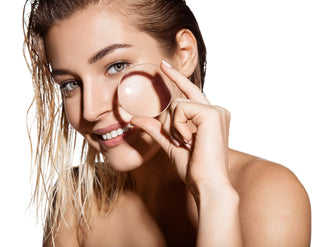As an aesthetician, not a day goes by where I'm not utilizing a peel solution, and I've had many clients ask me about mid-depth and deep peel solutions to address aging skin concerns. First and foremost, not all peels are the same and before you sign up for a medical peel, here's my advice on getting your best result.
What are chemical peels?
Most chemical solutions have been derived from nature but as science progresses, humankind has learned how to manufacture and create products that achieve a specific goal. Today, our favorite acids--glycolic, salicylic, and lactic--are made synthetically to work quickly and deliver maximum benefits.
All chemical peels are designed to remove layers and stimulate regenerative processes that help keep our skin youthful and in good health. The variable in each solution that determines its depth of penetration and type of exfoliation is the percentage and pH of the solution.
Overall, chemical peels are highly beneficial for:
- Fine lines and wrinkles
- Discolorations and uneven skin tone
- Acne, acne scars and post-inflammatory lesions
- Improvements to overall skin texture and pore refinement
- Hydration or oil control benefits for balanced skin
Home Peels, Aesthetic Peels and Medical Peels -- What you need to know about each.
Many types of exfoliating acids and enzymes are used in home care products. These acids help improve the absorption of product into the skin, where it can become more effective. A perfect example of this is the low percentage of glycolic and lactic acids in Mega C Complex. They help improve the penetration of peptides and vitamin C into your skin where they're needed to stimulate collagen synthesis. Exfoliation serums, including Resurfacing Peel treatment pads and Cranberry Exfoliating Peel contain higher percentages of glycolic acid with other actives to improve texture, hydrate the skin, and reduce some visible signs of aging.
Aesthetic peels and medical peels can be similar solutions--the difference is in how many layers of skin are removed. Aestheticians are licensed to perform very superficial to mid-depth peels in the skin. Physicians, PA's and nurses can perform deeper peels (like phenol or high dose TCA) that can remove most or all epidermal layers. Deep peels usually require a topical anesthetic or sedation before they're administered--if not, it's likely a superficial or mid-depth peel that may result in some mild redness and burning.
Things to Consider Before You Peel
What do you want to change about your skin?
Peels are not suitable for all skin concerns and they have the potential to create other problems with a deeper depth of peel. The most common questions I experience from clients are regarding peels for hyperpigmentation and skin discolorations, or wrinkles and elasticity concerns.
Peels are great for hyperpigmentation and sun damage, but only when paired with a brightening skin regimen. This suppresses melanocyte activity in the skin and without it, you have an increased risk of developing more pigmentation as a result of the peel. In my experience, slow and steady with chemical peels and home care is the best solution for most pigmentation concerns. BBL/IPL is better suited to remove pigmentation faster and with little to no complications (if you're a candidate).
Wrinkles and elasticity concerns we see on our skin's surface, but most of these concerns are caused by muscle, fat, and bone changes--things a peel will not address. Peels can address texture changes and hydration that make our skin look dull and tired, and it can soften the appearance of wrinkles by improving texture.
Alternative Treatments
Chemical peels are not for everyone which is why we have many different types of technology available that give you a customized and result-driven experience. Ultrasonic, microdermabrasion, micro needling... there's many options available and different price points to fit your budget.
ProFractional laser resurfacing and IPL/BBL can have a dramatic impact on your overall look. New technology allows us to measure the depth of treatment and customize the procedure, making it a safer and smarter alternative to mid-depth and deep peel solutions.
A combination of injectables, like Botox, Dysport, Xeomin, Radiesse, Restylane and Juvederm, can address lines, wrinkles and a loss of elasticity associated with natural signs of aging and sub-dermal changes we see on our skin.
Are you ready for downtime?
We want it now, no downtime, no pain, and it can't cost too much. Our routine facials all include a light chemical peel because they offer so many benefits with no downtime and--with good home care--they're integral at preventing premature signs of aging.
UV and pollution are the leading causes of aging skin, and correcting sun damage with lasers is less invasive, has less downtime, and is generally safer than a mid-depth to deep peel like TCA, Jessner, or Phenol solution. But either way, you can expect a little post-procedural care to ensure you get the safest results.
What have I experienced?
As an aesthetician, I have experienced most non-invasive and minimally invasive procedures. In my early aesthetic years, chemical peels were the standard at rejuvenation, but came with a 7 to 14 day recovery time--this has not changed with medical peels. However, laser technology has improved dramatically since the 90's and we can deliver a precision resurfacing procedure with as little as 48 hours of downtime.
In the end, there's multiple ways to rejuvenate your skin and always choose a provider who has your best interest in mind for the best and safest results.



